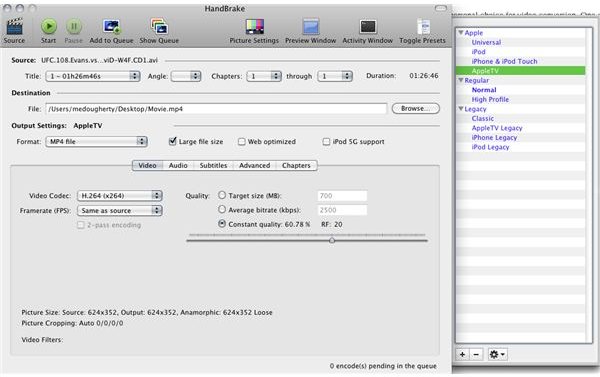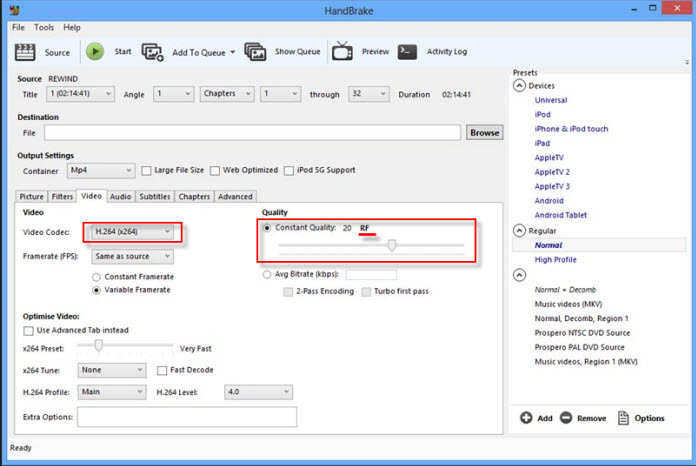
For variable bitrate, you have to specify an average bit rate, and this is why it offers a 2 pass option. This is also why average bitrate is mutually exclusive to RF - you either pick a constant quality, or a variable quality. The file sizes stay in a similar range (but not always), but you are spending more compute time doing the encoding, it takes more time to optimize the quality within the bitrate (file size) constraint. The slower encoder presets is how much CPU time you are throwing at the encoding. The RF number correlates to the bit rate - lower values mean higher bitrates which means larger file sizes. On the other hand, when I change the speed presets, the file sizes stay in a similar range (but not exact) but it takes longer to encode, but the quality can be noticeably different. The smaller the number, the bigger the file. Changing the RF roughly correlates to the file size. Do a 5 or 10 second preview and change the settings around and observe how it changes the file size and quality. The preview feature in Handbrake is great for learning and observing what the settings do. It you pick a "very fast" setting, it is not as efficient and will give you the same quality but in a larger file. If the RF value is not changed, a "very slow" setting is able to pack the same quality into a smaller file. I simply didn’t wish to speak in absolutes, in terms of file sizes.įor a fixed RF setting, you will get the same quality file but you will get different file sizes when you change the speed preset. But below that, that’s where the trade-off is. If someone has the patience and or processing power to use the highest quality encoding settings they will always be getting the most accurate, most efficient (in terms of file size) encode. Encoding is a calculation process but source files, can and do throw a spanner in the works. Medium/ HQ encode presets have accurate analysis modes but not as efficient encoding modes as the slowest settings.Īs I wrote, it’s completely source-dependent. Faster encode settings make more assumptions (guessing), missing out more information. The more accurate that analysis the more information it’s handling. RF encoding adjusts the bit rate to meet the value you’ve set, based on what its analysis tells it about each frame. The slowest highest quality encode settings can achieve both accuracy and efficiency.

The difference wasn’t a change in efficiency but in accuracy and that can often be the trade-off in the middle ground. The image quality of the faster encode was always worse, but in terms of pure file size, it was smaller.

I’ve seen several encodes where a more basic encode setting created a smaller file size (for the same RF) than mid-level HQ encode settings. The highest quality / slowest encoding settings are the most efficient, but in the middle ground, there is a trade-off. A higher-quality encoding setting (which for H264 is: very fast, fast, HQ, and Super HQ) at the same RF value will increase image quality but does not always create the same file size. H265 encoding may differ in that regard, I can only speak of my experiences with H264 encoding. It is the source and your eye that determines the most suitable RF. RF values are purely calculations, not valued judgments. Don't use the RF number as a guide, use your eyes. A higher bitrate medium speed encode will on average outperform a lower bitrate slow speed encode. I use H264 encoding, but it applies equally to H265 encoding.

Slow, medium, and fast are a trade-off between your patience and quest for the highest possible quality. The poorer the source the smaller the visible differences will be.īe aware, higher quality encoding settings can create larger file sizes, than a lower (faster) quality setting for the same RF. Ultimately though, the source file determines the extent to which slow, fast, and medium encodes differ from one another. So for the same RF value, fast, medium and slow encodes will generally produce three different qualities of similar, but not identical size encodes. The more accurate the process the more accurate the encode and the longer (slower) it will take. The differences are the extent to which each video frame is analyzed and on encoding, how accurately it uses that analysis (or assumptions it makes) to encode each frame.


 0 kommentar(er)
0 kommentar(er)
